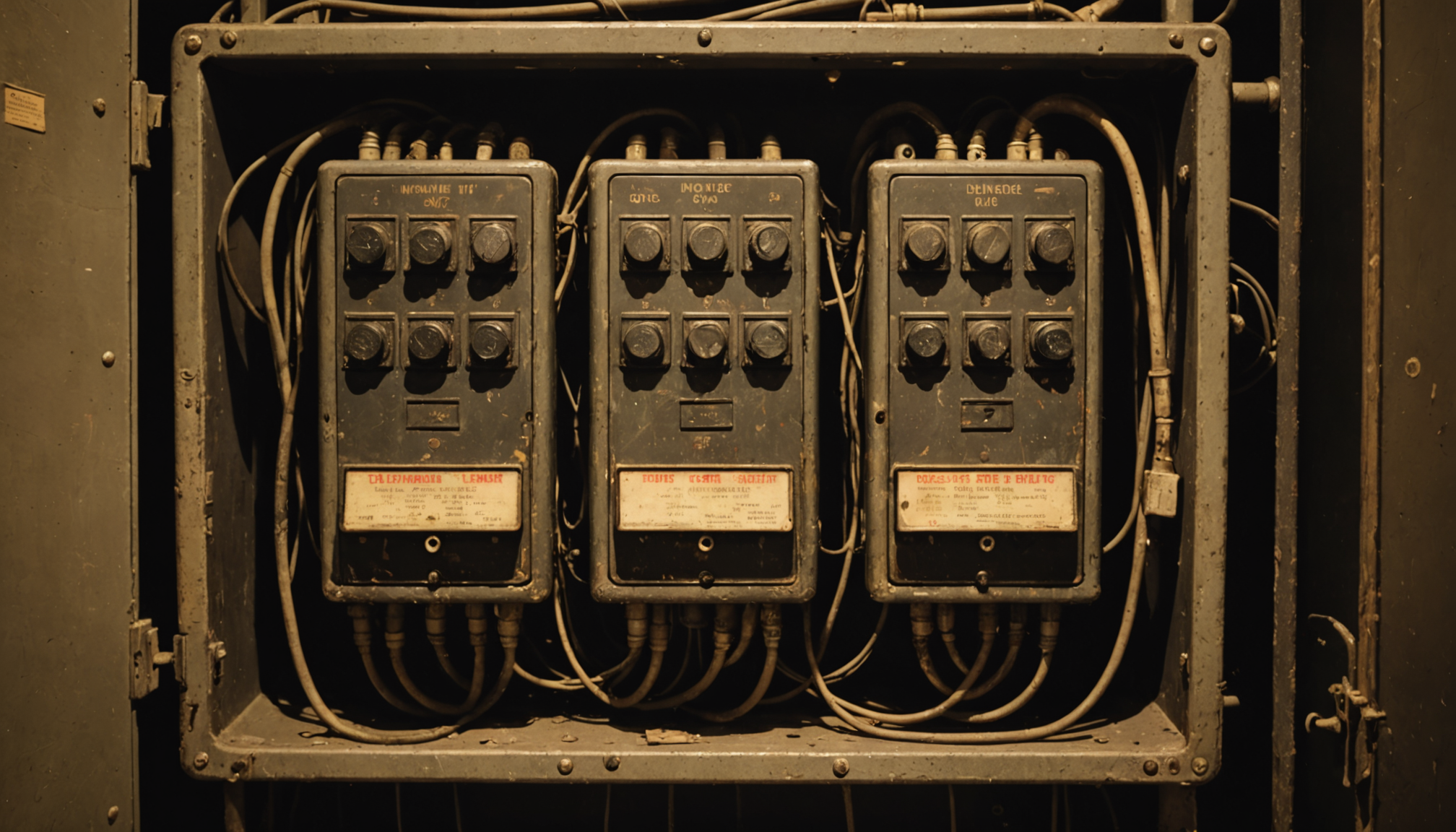Before embarking on any upgrades to your home’s electrical system, it’s crucial to assess your existing infrastructure. Understanding the current state of your system will help you make informed decisions about what enhancements are necessary and where potential safety risks may lie. This assessment involves evaluating the capacity, condition, and layout of your current electrical system.
Begin by examining the main electrical panel, also known as the breaker box, which is the heart of your home’s power distribution. Check how many amps your panel is rated for to determine if it can handle additional loads, especially if you plan to install high-wattage appliances or expand your home. Standard modern panels handle 200 amps, but older homes might only support 60 to 100 amps, potentially necessitating an upgrade.
A key part of your assessment should involve identifying the types of circuit breakers or fuses in use. Circuit breakers should easily reset if tripped, while fuses need to be replaced. Observe whether there are frequent trippings or blown fuses, as these can indicate an overloaded circuit or a short, pointing to an underlying issue that needs addressing.
Another essential element is the wiring throughout your home. Older homes may have outdated aluminum wiring, which can present a fire hazard. Copper wiring is recommended for its durability and conductivity. Inspect for frayed or damaged wires and ensure all connections are secure. Inadequate or exposed wiring can not only create inefficiencies but also significantly increase fire risk.
It’s beneficial to catalog your home’s existing electrical outlets. Modern homes should have outlets every 12 feet along a wall, with additional outlets in the kitchen, bathroom, and outdoor spaces for convenience and to prevent excessive and potentially hazardous extension cord use. Take note of any two-prong outlets, as they lack the grounding necessary for safety, and plan for potential upgrades to grounded, three-prong outlets.
Outlining your current electricity consumption patterns will help in the assessment process. Consider the number of heavy electrical devices in use, such as HVAC systems, hot tubs, or electric vehicle charging stations. Compare the actual load against the panel’s capacity to ensure there’s no chance of overloading circuits.
By the end of your assessment, you should have a clearer understanding of potential areas needing improvement. Here’s a simplified table to guide your review process:
| Component | Current Status | Recommended Action |
| Main Panel | Check amperage rating and age | Upgrade if under 200 amps or outdated |
| Circuit Breakers | Look for frequent tripping | Investigate load issues or faults |
| Wiring | Identify and replace outdated aluminum or damaged wiring | Upgrade to copper |
| Outlets | Inspect for grounding and spacing | Install additional or replace with grounded outlets |
By thoroughly understanding the components and capabilities of your current setup, you can strategically plan upgrades that will enhance safety and efficiency. Such a methodical approach ensures any future modifications are not only effective but also harmonious with your home’s existing electrical framework.
selecting the right components and materials
When you’re ready to proceed with upgrading your home’s electrical system, it’s crucial to select the appropriate components and materials to ensure the safety, efficacy, and longevity of your electrical upgrades. The right choices will depend on the specifics of your home and the needs identified during your initial assessment. Here’s a step-by-step guide to help you through the selection process:
- Determine the Voltage and Amperage Needs:
- Calculate the total load that your new systems and appliances will require. This might include kitchen appliances, HVAC systems, or electric vehicle chargers.
- Ensure that the selected components match your panel’s capability. For instance, most contemporary homes are set for 200 amps; ensure your components can work within these limits.
- Select Proper Circuit Breakers:
- Choose breakers that are compatible with your existing panel and suitable for the loads they will manage. If you have an older home, consider updating to modern arc-fault or ground-fault circuit interrupter breakers for increased safety.
- Match breaker capacity correctly with the circuit wires to avoid overloading and to comply with safety codes.
- Choose Appropriate Wiring:
- For new wiring, opt for high-quality copper cables due to their excellent conductivity and durability.
- Consider the gauge of wire needed based on the circuit’s amperage requirements. Larger appliances may require thicker gauge wires.
- If rewiring existing systems, ensure compatibility with existing circuits and consider color-coding wires for easy identification.
- Select Quality Outlets and Switches:
- Opt for grounded, three-prong outlets, particularly for areas prone to moisture, such as kitchens and bathrooms.
- Consider tamper-resistant outlets in homes with children for added safety.
- For added convenience, choose models with USB ports for charging devices and ensure the switches are rated for the load they will control.
- Choose Energy-Efficient Lighting Fixtures:
- Replace traditional bulbs with LED options to enhance energy efficiency and reduce costs in the long term.
- Select fixtures that fit the style and design of your home and verify compatibility with any dimmer switches or smart home systems you plan to use.
- Consider Advanced Technology and Smart Systems:
- Explore smart home technologies that can integrate with your electrical system for enhanced control and efficiency, such as smart thermostats, lighting, and security systems.
- Ensure these technologies are compatible with your existing infrastructure and future-proof as much as possible by choosing devices that offer updates and upgrades.
By carefully selecting the right materials and components, you’ll form a solid foundation for a safe, efficient, and future-ready electrical system. This thorough preparation will not only keep your home compliant with safety standards but will also accommodate future technological advancements.
safely handling electrical upgrades
When it comes to implementing electrical upgrades in your home, ensuring safety is paramount. Conducting these upgrades requires a meticulous approach to minimize risks and protect yourself and your property from potential hazards. Here are some key practices and tips for managing your project safely:
Understand the Risks: Before beginning any electrical work, familiarize yourself with the inherent risks involved, such as electric shock, electrocution, and fires. Recognizing these dangers will underscore the importance of adherence to safety protocols and precautions.
Turn Off the Power: One of the most critical safety measures is to always turn off the power at the main breaker before working on any electrical circuits or devices. This ensures that you are not working with live wires and significantly reduces the risk of electric shock.
Use Proper Tools and Equipment: Ensure you have the necessary tools, such as insulated screwdrivers, wire cutters, and voltage testers. Using tools specifically designed for electrical work minimizes the risk of injury and equipment damage. Insulated tools are essential as they provide an additional layer of protection against electrical currents.
Wear Personal Protective Equipment: Wear protective gear, such as gloves and safety goggles, to shield yourself from potential sparks or debris. Non-conductive gloves help in preventing shocks, while safety goggles protect your eyes from potential bursts of electrical arcs or flying particles.
Follow a Step-by-Step Approach: Methodically work through the electrical upgrade process from start to finish. Do not rush or skip steps, as haste can lead to errors and unsafe conditions. Make a checklist to keep track of each phase, ensuring that every component of the system is addressed and secure.
Understand the Wiring Diagram: Before altering any wiring, study and comprehend the wiring diagram for your system. Knowing the layout helps you make accurate connections and prevents wiring mistakes that could lead to short circuits.
Avoid Overloading Circuits: Monitor how much load your circuits are expected to handle. Never exceed the circuit’s rated capacity as it increases the risk of overheating and electric fires. Use appropriate circuit breakers that can handle the expected load and prevent overcurrent situations.
Practice Good Wiring Habits: Ensure that all connections are secure and comply with the best practices in terms of neatness and organization. Avoid creating splices or circuits that are difficult to follow, which can create confusion in troubleshooting and maintenance efforts.
Label Everything: Properly label all circuits, breakers, and outlets to ensure clarity in the system, especially if someone else may need to access it or perform maintenance in the future. Clear labeling aids in quick identification of circuit functions, making future repairs or upgrades much simpler and safer.
Stay Informed about Current Standards: Electrical standards and best practices evolve; staying updated on national electrical codes and industry standards is crucial for implementing safe and compliant upgrades. This knowledge ensures your upgrades not only improve your home’s safety but also meet modern safety requirements.
By meticulously managing each aspect of your electrical upgrades with safety as a priority, you’ll create an environment where electrical systems operate efficiently and securely. This careful attention to detail fosters a safer home and reduces the likelihood of encountering critical electrical issues in the future.
compliance with local electrical codes
Navigating the intricacies of your local electrical codes is essential when upgrading your home’s electrical system to ensure both safety and legality. Local electrical codes often align closely with the National Electrical Code (NEC), but localities may have additional requirements based on regional safety concerns or environmental conditions. Familiarizing yourself with these codes is a critical step in planning your project.
Begin by obtaining a copy of the local electrical code from your municipality. This document will serve as your roadmap, providing specific guidelines on everything from the types of materials that can be used to the installation processes that need to be followed. It’s important to pay attention to details such as the required spacing for outlets, the height for switches, and specific grounding methods, as these vary by location and can impact both safety and functionality.
Understanding permit requirements is another crucial element. Most electrical upgrades, especially those involving substantial changes to the existing system such as panel upgrades or rewiring, will mandate a permit. These permits ensure the project is reviewed and inspected by a qualified inspector, offering a level of protection by verifying that the work meets safety standards. Failure to secure the necessary permits can result in fines and complicate future sales of the property.
If your upgrades include major modifications, such as installing new circuits or increasing the load capacity of your service panel, you’ll likely need an inspection. During this inspection, all work will be thoroughly evaluated for compliance with the local codes and the administrative processes of your jurisdiction. The inspector will examine the quality of materials and the accuracy of the installations, ensuring all elements adhere to legal standards. Passing this inspection not only keeps your home safe but also grants peace of mind knowing the changes are officially sanctioned.
Staying abreast of code updates is essential, as electrical codes are periodically revised to incorporate advances in technology and revised safety protocols. Engaging with community resources, such as local building departments or professional organizations, can provide insights into recent changes that might affect your project.
For complex upgrades or if you’re uncertain about specific code requirements, consulting with a professional electrician can be invaluable. An experienced electrician will be familiar with both national and local codes and can guide your project to ensure full compliance. Professionals can also help navigate the administrative aspects of permitting and inspections, streamlining what can be a complex procedural landscape.
Remember, the primary aim of these codes is to protect you and your home from electrical hazards, ensuring that your system operates efficiently and safely. By thoroughly understanding and applying these regulations to your upgrade project, you’ll not only safeguard your home but also potentially enhance its value and reliability.
hiring a professional electrician
Upgrading your home’s electrical system can be an intricate and potentially dangerous task, which is why hiring a professional electrician is often a prudent decision. Professionals come equipped with the experience, expertise, and tools necessary to navigate the complex world of electrical upgrades safely and efficiently.
When considering professional help, start by seeking recommendations from trusted sources such as friends, family, or neighbors who have had recent electrical work done successfully. Checking online reviews and ratings of local electricians can also provide insights into their reputation and reliability. Once you’ve shortlisted potential candidates, ensure they are both licensed and insured, which is a non-negotiable requirement. Licensing confirms that the electrician has undergone the necessary training and met the required professional standards, while insurance provides protection in case of any accidents or damages during the project.
It’s advisable to request quotes from multiple electricians, as this will give you a clearer picture of the market rates and help you budget effectively for the project. Be wary of quotes that are significantly lower than others, as this may suggest the use of subpar materials or shortcuts in service that could compromise safety and quality. Instead, opt for transparency; ensure the quote is detailed, covering the scope of work, materials, labor, timeline, and any potential additional costs.
An experienced electrician will commence with a thorough inspection and evaluation of your existing electrical system. This initial step is critical as it identifies potential safety hazards and assesses the capacity for any new installations. Collaborate closely with your hired professional to discuss your specific needs and preferences, whether you’re considering new circuit installations, energy-efficient lighting, or smart home systems.
During the process, communication is key. Ensure the electrician explains each step of the upgrade, providing you with a better understanding of what improvements are being implemented and why. This not only gives you peace of mind but also empowers you to make informed decisions about future electrical needs or upgrades.
A competent electrician will adhere strictly to local electrical codes and standards, ensuring your upgrades are not only safe but also compliant with legal regulations. Upon completion, they should conduct a final walkthrough with you, explaining any changes made, showing you how to use new installations properly, and advising on maintenance for longevity and safety.
Ultimately, investing in a professional electrician is an investment in the safety and value of your home. Their expertise ensures that your electrical system not only meets your current needs but is prepared for future demands, offering you both assurance and enhanced performance.
In conclusion, upgrading your home’s electrical system requires careful planning and attention to detail. From assessing your current setup to selecting the right materials and ensuring compliance with local codes, each step is crucial in creating a safe and efficient electrical environment. While some may consider tackling certain enhancements as DIY projects, the expertise of a professional electrician ensures the job is handled safely and correctly, reducing the risk of future issues and providing peace of mind. With these strategies, you can effectively enhance your home’s electrical system to meet your needs today while preparing for the possibilities of tomorrow.


